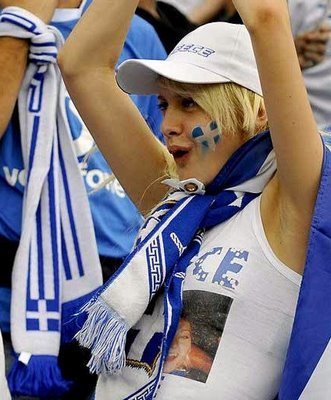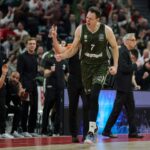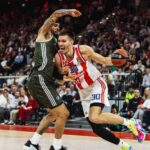 On the eve of Eurobasket 2009, Ball in Europe’s man in Italy, Francesco Cappelletti, looks back at this summer’s youth competitions to assess where Europe’s national programs stand and where they’re headed. From where will the future be launched? Read on!
On the eve of Eurobasket 2009, Ball in Europe’s man in Italy, Francesco Cappelletti, looks back at this summer’s youth competitions to assess where Europe’s national programs stand and where they’re headed. From where will the future be launched? Read on!
One day until Eurobasket 2009: It has been a full summer which started with three youth competitions. These are useful to frame a speech about the basketball we are now playing in Europe, in attempting to open a bigger discussion on traditions, changes and examples European schools give us from time to time.
By the way, the European U20, World U19 and European 18 Championships aren’t as representative as one would imagine, but they do representative a basic principle upon which compare different worlds might be compared.
In the U18 European Championship, physical impact of an individual is typically much more important than team’s: Dejan Musli dominated under the basket for winning Serbia; Enes Kanter destroyed every opponent in the paint (averaging 18 points and 16 rebounds per game) to lift his Turkey to third place; speedy Toni Prostran delighted the crowds (20.9 points and 7.9 assists per game) but wasn’t enough to move Croatia from 8th place. Again: physical impact trumps the heretofore less-relevant tested team system.

Something to cheer about -- for now
An example is provided by Greece, who managed to place second – behind only Team USA – at the U19 World Championship. How was this possible? Simply, if boys are good to stay on court, Greek teams don’t hesitate in trusting them, freeing space and minutes traditionally reserved for not-so-good Euro or US players in other leagues (primarily Italy).
As Seth Curry, Tyshawn Taylor and Gordon Hayward practice under the orders of those trainers the best American coaching can provide, Leonidas Kaselakis, Kostas Papanikolau and Giorgos Bogris are launched in Esake, to face basketball their maturity is should be aligned with, rather than simply towering above those of the same age in a national youth league.
Some notes on youth competitions: Pure physical impact still lingers (Croatia finished 3rd thanks to its over-207cm frontline of Delas, Radosevic, and Zubcic). The U20 European Championship showed us why the seedtime is over: Greece won the final game against a Team France which looked like Sloukas & Teammates (that’s for the five men with senior’s use: Edwin Jackson, Kevin Seraphin, Antoine Diot, Fernando Raposo, Thomas Heurtel); an unpredictable Italy without stars grazes the podium, where Spain stands.
The U20s represent another level of maturity, with experience and a team system counting a bit more, so it’s not strange to see the competition’s top scorer (Robin Benzing with 22.7 ppg) coming from 14th-place Germany or that two of the major talents in the tournament (Nikola Vucevic and Sehad Sehovic of Montenegro) were exiled to a smothering 7th place. The U20s are nearly in the adult world, the differences between who’s just playing at that level and who’s not become abysses.
Such a long story to say what? Well, we’ve cleaned our mind and we’re ready to consider a larger concept in trying to make a picture of the overall European basketball state of art. Because European basketball is not only Euroleague and Eurocup. Beyond them – or rather “before” the big-league levels – there’s a movement, many movements, which claim their role and importance. Let’s take a look at the whole panorama: What emerges?
BALKANS: Moving on a difficult path of economic problems and player theft year after year, those nations who represented the former Yugoslavia have inaugurated a philosophy many other European schools should make own, discovering new young players and maturing them via constant floor vision. Far from the era of Aleksandar Djordjevic, Predrag Danilovic, Drazen Petrovic, and Dino Radja, a generational substitution is guaranteed to create the desire and competitive spirit the Croatians, Serbians and Slovenians already possess.
In the last few years, we’ve seen a few great guards and a lot of forward/centers whose potential is unlimited and specially unexplored, because Nikola Pekovic and his type develop later than Roko Ukic and Goran Dragic, for example. No hurry: the celebrated schools at which to learn fundamentals are in the Balkans, just as in Belgrade, Lubiana or Zagreb. The big and wealthy clubs haven’t come to go shopping, yet, though.
GREECE: The new El Dorado lives in a nearby nation. Maybe Spain has achieved more recent success, but the youth competitions’ results show a Greece in which the national team keeps on finding new resources of unimaginable quantity, if you account for a population of just 11 million. Greece’s ability to build a squad from the youngest ages, or the leadership that point guards take at once is amazing, with the examples of Papaloukas and Diamantidis well noted. A reasoned basketball, conceived of not to revolve around a superstar (whatever role he has) but to improve the entire system, includes those centers seen as weapons even if they’re heavy and not so gifted offensively (see Ioannis Bouroussis, Kostas Tsartsaris, Sofoklis Schortsianitis); and this is one reason why Italy, interested and stupidly conviced it would be easy to produce many Andrea Bargnani lookalikes, doesn’t provide effective power forwards and centers.
Last but not least, Greece boasts an enviable availability at medium-level clubs to give time to prospects and also role-players who will be able to become elite only by challenging. Consequently, after some years of training in Maroussi, Panionios, AEK, these players comprise the backbones of Panathinaikos and Olympiacos – two of the top five European clubs, of course.
ITALY: Heading Northwest, Italian national teams are Serie A’s mirrors. Italy has an historical movement which has changed its way of thinking about its professional clubs after years of European delusions; to return to the top, Italy has preferred to overpay moderately-skilled Bosman players instead of insisting on local product. That’s the situation of Dmitri Lauwers, last season with Virtus Bologna, while Pietro Aradori (the former, more respected teammate of Danilo Gallinari on Casalpusterlengo five years ago) has had to wait for Biella’s coach Luca Bechi to become a top guard worthy of a call by Carlo Recalcati.
The same Recalcati shows us why Italy is an elite basketball nation no more: Stationary is his bench which has not encouraged results since the gold medal win at Eurobasket 1999, a moment from whom Team Italy has taken many steps back. Italian basketball – as in Italian politics, that’s for sure – lacks the will to gamble on youngers, subsequently constrained to emerge in small markets (e.g. Montegranaro, Teramo, Biella) because the big clubs are lost in the fight against FIP to obtain new and more manageable rules reserved for US and European players; and when they realize there’s something good also in the “Belpaese,” they overpay and put under immoderate pressure those unlucky ballers, ending with the release of a Vitali (no coincidence, that name) who has been allowed just a season to show his skills.
What’s more, there is no plan for youths; the best coaches are gone and don’t even think about returning, so that youth activity is reduced to a pathetic recruitment race between Benetton Treviso and Montepaschi Siena, involved in winning an amount of championships that don’t necessarily mean bringing up players ready for Serie A and European competition.
Extreme paradoxes: Luigi Datome has had to wait for Jasmin Repesa (Croatian) and Andrea Renzi has had to wait for FYR Macedonia native Oktay Mahmuti to see the floor. There’s something wrong in Italy, and it seems we are very distant from changing the scene to bridge the increasing talent gap.

Vive le Team France!
FRANCE/SPAIN: We pass over the Alps, and luckily we find a very different situation from Italy’s. The French movement doesn’t have noticeable traditions and roots, but does has the great merit of having created the INSEP, preparation schools which welcome the national best athletes and send them to the most suitable sport for themselves. Yakhouba Diawara, the Pietrus brothers, Johan Petro and many other national points of pride came from there. Surely, France has to thank colonialism, but nobody can deny the improvements made by those boys whose names are not Parker, Batum, Noah, and Turiaf.
A spectacular way of thinking about basketball is happening in Spain, probably the modern European ballin’ center. It all started due to the golden classes of the early 1980s, and it continues with the late 80s/early 90s-born, not so dominant individually, but of an elite level if we talk about group. With the fresh examples of Spaniard NBA players, it’s difficult to imagine that a movement so launched not only on floor but also economically and as European basketball’s guide, could soon suffer an unexpected stop.
THE EAST: The ending of the USSR has obviously left pros and cons; it’s up to you to judge if the rigid discipline that’s still present in East Europe is positive or not. I think there is a limit, however. In Russia, Poland, or Latvia, a 210-cm tall player able to face the basket and hit from outside, will be stationed in the paint (OK, Andrei Kirilenko is an exception), because of a military-like respect for roles connected to heights and weights. Physically, Baltic players develop earlier, and coaches try to make the best of this window of opportunity. When 22-23 years old, players are already grownup technically and physically, so the naturalized J.R. Holden or Kelly McCarthy help cover the faults local players still have. No teachers, no willingness to cross the frontiers, no future.
There’s little evidence to believe in a fast U-turn here, either; Anton Ponkrashov and his companions don’t seem up to the reputation of a presumed European championship. That gold medal dangerously recalls the winning Greek team from the 2004 European Soccer Championship.

Decade of the (Lithuanian) dragon?
A different condition concerns Lithuania, a sort of little Serbia open to influences coming from West, a place where young stars aren’t afraid to fly to US colleges to test their own abilities even if they could dominate in Europe and getting the best a player could ask for. Former Yugoslavian schools were the recommended houses at which to learn fundamentals and the right way to figure out what it takes to win, but after the wonderful human basketball clinic Dejan Bodiroga what have Balkan schools offered to us over the past 10 years, except a glorious slate of big men (Nenad Krstic, Nikola Pekovic, Nikola Vujcic) and many shoot-first playmakers (Milos Vujanic, Marko Popovic, Jaka Lakovic)? Little material. So, Lithuania is at the top at the moment, and the examples to bear this out are evident; the national team can count on polished players Sarunas Jasikevicius, Ramunas Siskauskas and Ksistof Lavrinovic to exploit a huge batch of forwards and centers close to the next level (Donatas Motiejunas is one of them). Even more, the fact basketball is a religion there, and the modern structures in place for the Lithuanian game, make the difference.
GERMANY, TURKEY, ISRAEL: Germany is paying the price for Nowitzki’s aging, and the country will regret not investing in a movement surpassed by winning youth soccer, whereas the local management has found an ideal solution to solve numerical problems by opening the national team’s doors to easily naturalized players.
Turkey has a good old nucleus; however, Bogdan Tanjevic (and, in a lesser way, Ergin Ataman) has failed with his plan designed around young players, and if the biggest clubs neglect local product to rely on US and European players, the opportunities for Turkish ballers to compete at higher levels will decrease in a hurry. Nevertheless, the Turkish First League doesn’t provide local players competition tough enough to develop their skills. Good luck, Enes Kanter, and here’s hoping you avoid the pitfalls of Cenk Akyol’s career!
Awesome news arrives from Israel, where an expansion of formative centers outside Tel Aviv (Jerusalem, Haifa, Hasharon) has made for interesting support to a movement which has many practisers but an incredible lack of guards after Oded Katash, if we estimate the value of a strong class of forwards and centers.
That’s it for the prologue. Now let’s plunge into Eurobasket 2009, and we’ll see if these theories are right or wrong. Back after the tournament!
— written by Francesco Cappelletti




